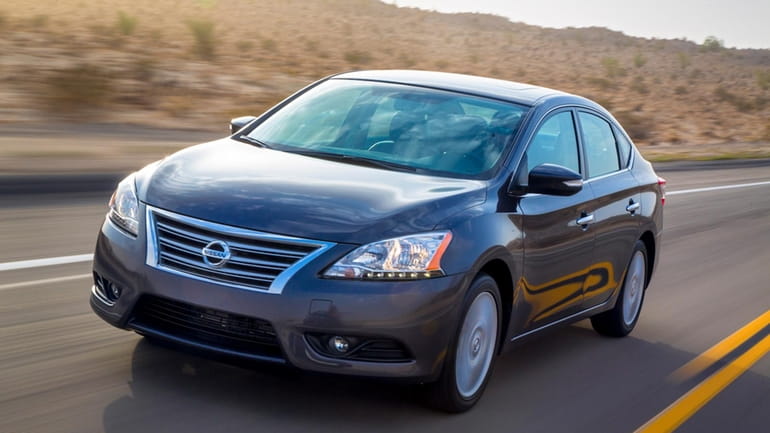2013 Nissan Sentra: Ready to compete with Civic, Corolla

Nissan's 2013 Sentra continues the brand's product onslaught as the third of five all-new vehicles being introduced in a 15-month period. Credit: Scripps Howard News Service/Nissan
The old adage among automobile designers is that you want to make a big car drive smaller, and a small car drive bigger.
Then there's the 2013 Nissan Sentra -- which not only drives bigger, it is bigger, growing from a so-so compact into a solid contender in a class that has been dominated by the Honda Civic and Toyota Corolla.
The new Sentra -- the seventh generation of a model that dates to 1982 -- has been redesigned, with a larger profile and attractive new styling that makes it look like a midsize car. And, in fact, the government says it is. With a total of 111 cubic feet of interior volume -- 96 passenger and 15 in the trunk -- the Sentra fits comfortably in the midsize class.
It gives the Sentra bragging rights over the Chevrolet Cruze, Ford Focus, Honda Civic and Toyota Corolla. The only exception is rear headroom, which trails all of those except the Corolla. So far, the Sentra comes only as a four-door sedan, where its competitors also offer hatchbacks and coupes.
Even at that, the Sentra has plenty of noggin space for six-footers. It also has a surprisingly decent center seating position in back. As with most cars, the cushion is high and hard, but there's still enough headroom for a smaller adult, along with ample foot space because of a small floor hump.
There's an all-new 1.8-liter four-cylinder engine. It delivers 130 horsepower to the front wheels through a continuously variable automatic transmission (CVT), which uses belts and automatically adjusting pulleys to multiply the engine's power seamlessly, without shift points. The Sentra's CVT also incorporates planetary gears to help deliver a broader ratio of gearing than a seven-speed automatic transmission, according to Nissan.
Nissan has more experience with CVTs than any of the major manufacturers, and it shows in the Sentra. Although it exhibits some of that engine revving that makes it feel as if something is slipping in the transmission, the effect is minor. With no shift points, the Sentra gets up to speed effortlessly.
There are three driver-selectable drive modes: normal, eco and sport. Each provides a different throttle response, and transmission and other tuning for performance or fuel economy. In eco, for example, the air conditioning draws less power from the engine.
Also offered is a six-speed manual gearbox, though it is available only on the $16,770 entry-level base model, which is a decently equipped car aimed at bargain hunters who enjoy shifting for themselves. However, the effort doesn't produce additional fuel economy.
The manual gearbox model has an EPA city/highway/combined fuel consumption rating of 27/36/30 mpg. The efficient CVT, which costs an additional $1,270, delivers 30/39/34.
However, the stick shift is entertaining. The shift linkage is positive, with few lumpy areas. Combined with a soft clutch that doesn't grab, the combination makes for a sporty experience.
The biggest downside to the base S models, both CVT and stick, is that they do not come with cruise control, which could be an annoyance on a long trip. To get that, you must move up to one of the better-equipped models: S at $18,570, SR at $19,650 and SL at $20,540, all of which come only with the CVT.
With either the stick shift or the CVT, the four-cylinder engine provides adequate power in urban and freeway driving, though it won't win drag races with turbocharged fours or six-cylinder engines.
Inside, manual seat adjustments, along with a tilt and telescoping steering wheel, provide enough range to accommodate most drivers. As with almost every new car today, the Sentra offers the obligatory technical adornments, including Bluetooth communication, Pandora radio and an optional Bose audio system.
The test car had the Nissan Connect system, with navigation, that uses a small touch screen to deliver traffic warnings and rerouting, weather information, and points of interest. It also included a rearview camera and easy-fill alert, which sounds the horn when tires are pumped to the correct pressure.
Out back the trunk has 15 cubic feet of space, large for the compact class, where the Sentra competes. However, the C-hinges are not protected and could damage luggage. The rear seatbacks fold for additional cargo-carrying capability.
The test car was the SL, fully loaded with options that brought its suggested sticker price to $23,420. Among them: pushbutton starting, dual-zone climate control, leather-covered seats, antilock rear disc brakes, motorized glass sunroof, rear-view monitor and 17-inch alloy wheels.
SPECIFICATIONS
Model: 2013 Nissan Sentra SL four-door sedan.
Engine: 1.8-liter four-cylinder, 130 horsepower.
Transmission: Continuously variable automatic.
Overall length: 15 feet 2 inches.
EPA passenger/trunk volume: 96/15 cubic feet.
Weight: 2,851 pounds.
EPA city/highway/combined fuel consumption: 30/39/34 mpg.
Base price, including destination charge: $20,540.
Price as tested: $23,420.
Contact Frank Aukofer at driveways6(at)gmail.com.
